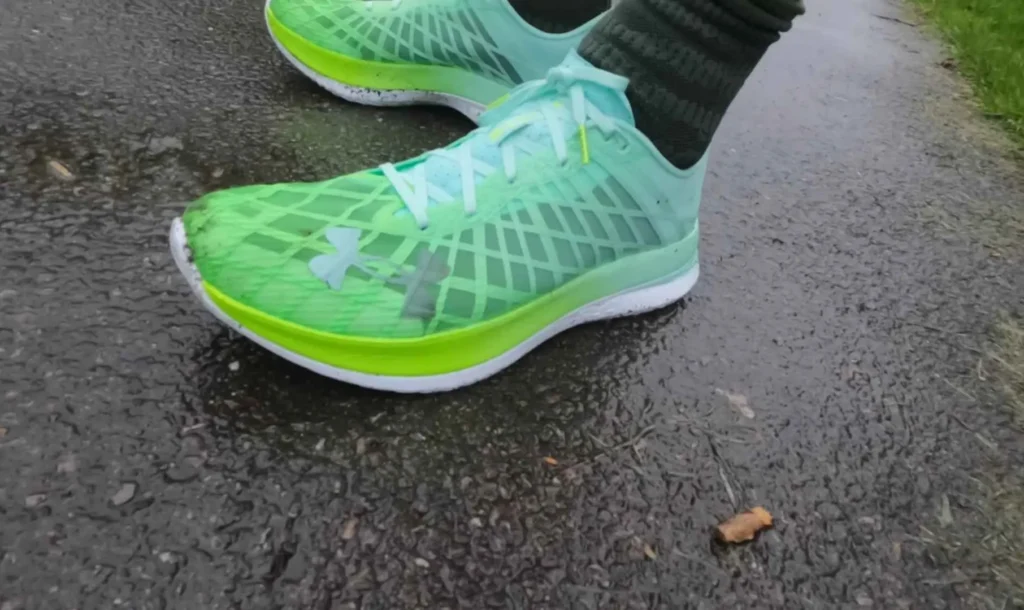When it comes to selecting the right pair of shoes, slip resistance is a crucial factor, especially if you work in environments that pose a risk of slipping or require extra traction.
In this blog post, I will share my personal experiences with Under Armour shoes and their slip-resistant qualities.
As someone who has worn various models of Under Armour shoes in different situations, I’ll provide insights into their performance on slippery surfaces and their overall slip resistance.

Understanding Slip Resistance
Slip resistance refers to a shoe’s ability to maintain traction and grip on various surfaces, preventing accidental slips and falls.
It relies on factors such as the outsole material, tread pattern, and overall design of the shoe.
Keep in mind that slip resistance can vary depending on the specific model and intended purpose of the shoe.
You May Also Like – Do Under Armour Shoes Run Big or Small? My Personal Experiences
My Experiences with Under Armour Shoes
Throughout my personal experiences with Under Armour shoes, I have found that they generally offer reliable slip resistance.
Whether I’m walking on wet pavements, smooth floors, or slippery gym surfaces, I have felt confident in the grip and traction provided by Under Armour shoes.
Outsole Design and Tread Patterns
Under Armour incorporates innovative outsole designs and tread patterns into their shoes, which contribute to their slip-resistant qualities.
These features are specifically engineered to enhance traction and provide stability on various surfaces.
The deep grooves and multidirectional patterns on the outsole help to channel water, dirt, and debris away, reducing the risk of slipping.
Water-Resistant Materials
Many Under Armour shoes feature water-resistant materials, which can also contribute to their slip resistance.
These materials help repel moisture, preventing it from seeping into the shoe and compromising traction.
The added protection against water enhances the shoe’s overall grip on wet surfaces.
Purpose-Specific Shoes
Under Armour offers a range of shoes designed for specific activities such as running, training, hiking, and work.
Some models, particularly those intended for work or outdoor activities, are explicitly labeled as slip resistant.
These shoes often have specialized outsole materials and patterns that prioritize enhanced traction on slippery surfaces.
Versatility and Everyday Use
Beyond specific work or outdoor environments, I have found that Under Armour shoes offer reliable slip resistance for everyday use as well.
Whether I’m navigating through rainy streets or walking on polished floors, I appreciate the peace of mind that comes from knowing my shoes provide a secure grip.
Read Also – Why Under Armour Is So Expensive? (Top 3 Reasons)
Does slip resistant mean non-slip?
Certainly! When we refer to slip-resistant or non-slip shoes, we are describing footwear that is specifically designed to minimize the risk of slipping on slippery surfaces.
While the terms may not have a strict technical differentiation, they convey the same fundamental concept of improved traction and grip.
Slip-resistant shoes are engineered with features that enhance their ability to provide traction on various surfaces.
These features can include specialized outsole materials, tread patterns, and technologies that increase friction and grip.
The outsole materials used in slip-resistant shoes are often designed to be more resistant to slipping on wet or oily surfaces.
The tread patterns on slip-resistant shoes are strategically designed to channel away liquids and debris, allowing the shoe to maintain contact with the ground and reducing the likelihood of slipping.
These patterns typically consist of deep grooves, multidirectional patterns, or specific lug designs that maximize traction.
It’s important to note that while slip-resistant shoes are designed to minimize the risk of slipping, no shoe can guarantee complete slip-proof protection on all surfaces.
Factors such as the type and condition of the surface, the presence of contaminants, and individual walking or running style can still influence slip resistance.
However, slip-resistant shoes provide an added layer of protection and significantly reduce the chances of accidents caused by slipping.
In summary, slip-resistant and non-slip shoes share the common goal of providing improved traction and grip on slippery surfaces.
Both terms imply that the shoes are designed to minimize the risk of slipping.
While no shoe can offer 100% slip-proof assurance, slip-resistant footwear incorporates specialized features to enhance traction and reduce the likelihood of accidents caused by slips and falls.
Related Article – Are Dansko Clogs Slip Resistant? My Personal Experience
Conclusion
Based on my personal experiences, Under Armour shoes generally exhibit slip-resistant qualities.
Their outsole designs, tread patterns, and water-resistant materials contribute to reliable traction on various surfaces.
However, it’s important to note that slip resistance can vary depending on the specific model and its intended purpose.
If slip resistance is a top priority, it’s advisable to opt for shoes specifically labeled as slip-resistant or designed for work environments.
As always, individual preferences and experiences may vary, so it’s recommended to read customer reviews and try on different models of Under Armour shoes to find the best fit and slip resistance for your needs.
When it comes to staying safe and confident on slippery surfaces, Under Armour has proven to be a reliable choice in my personal journey.